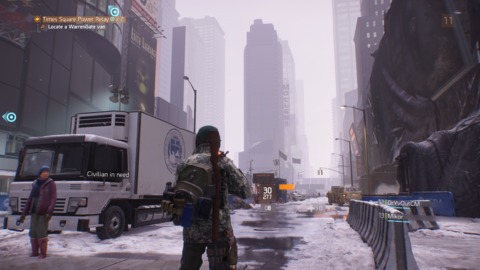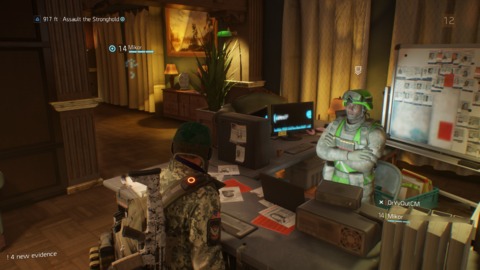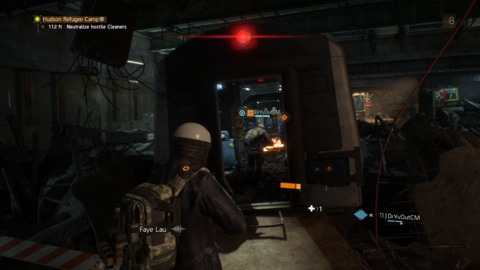Tom Clancy's The Division Review

I really enjoyed much of my time with Tom Clancy's The Division, but I don't think it's a particularly great game. On paper, The Division is precisely the Ubisoft open-world template, where the side tasks are somehow even more repetitive than usual and tower climbing has been replaced with running up to a person or "situation board" at every safe house to fill in your map with a ton of little, cookie-cutter objectives. But the Diablo/Destiny-like nature of its occasional online play gives it a social hook that helps overcome the game's lame attempts at storytelling, its city full of repetitive tasks, and even its complete non-ending. It breaks down like this: if you tend to play these sorts of games by yourself and don't like it when player-on-player conflict can have consequences, you probably won't warm up to The Division. But if you like to group up and do stuff with a set of friends, The Division's competent third-person shooting and its main missions are engaging enough to keep you going. And hopefully the chatter with your friends about hockey scores or where to get the best steak sandwiches or whatever will be good enough to keep you moving through the game's more monotonous moments.
The Division is an always-connected third-person shooter that lets you get into groups of up to four players as you take back a quarantined section of New York City from various looters and opportunists who are attempting to take control of the virus-laden city. It has a setting and a premise, but it's very light on actual story. Instead, the point is to get as much loot as you can. You can grab it from the dead bodies of your enemies. You'll find it in chests. You'll get it as a mission reward. You can even craft your own. But the real story in The Division is watching the numbers go higher. You'll find better armor with various stats. You'll re-roll some of those stats until you find ones that are to your liking. You'll slot mods onto your weapons and armor to make them more effective. You'll stare at stat screens that could have been laid out in a more informative manner and puzzle out which gun parts you should strap to your gun to make it great for murdering bad guys... or good guys, depending on what you're up to. The story doesn't really wrap up so much as it stops, as if it really wants you to focus on the numbers instead of the stuff you're actually doing.
That stuff? Shooting people in the face and hoping that they drop cool stuff. But since this game is semi-realistic, all that cool stuff is based on real weaponry. So the standard leveling curve that you'd expect from an action-RPG is in place, but you're just getting the same guns with higher levels and damage numbers attached. One AK-47 fires just like another, but your level 30 AK-47 is going to do more damage than your level 8 AK-47. And both of them require you to empty a fair amount of your magazine into the opposition in order to bring down enemies that are at or above your level. You have to really lean on a hardcore suspension of disbelief to care about the proceedings, but if you're able to write all that stuff off as "typical video game shit," it's fine.

While the side stuff may be monotonous, the game's main quests take you through some unique locations. You'll stomp through police stations, power stations, Grand Central Station, apartment buildings, and all sorts of other hastily fortified positions. They play like a good co-op cover-based shooter should. The action scales up if you're playing with other people and the AI, though prone to moments of complete idiocy, gets pretty good at flanking you if you aren't good enough at flanking them first. It feels hectic, and your various abilities and loadouts can make or break your team, especially at the higher difficulty settings. Those hairy moments, where your team is constantly saving each other and loosely coordinating attacks on waves of enemies, are the best that The Division's co-op side has to offer.
Then there's the Dark Zone. The entire middle of the city is cordoned off due to extreme contamination, so naturally you'll want to go there with some friends and see what's up. This is where the game's hybridized form of competitive multiplayer surfaces. This zone is one large death trap, with enemies that are at your level or tougher. They'll drop good loot, but the loot is "contaminated." So if you want any of it for use in the rest of the game, you have to call in a helicopter at a designated extraction spot and airlift those items out. Extracting that loot requires you to fire a flare gun, which tends to alert another wave of tough enemies, who descend upon your extraction spot to take care of you. If you die, you'll drop your contaminated items and lose a chunk of Dark Zone experience points, which accrue on a separate meter. Also--and this is the important part--other players can turn "rogue" and gun you down at any time, giving them ample opportunities to steal your loot for themselves. Once you do significant damage to a human player, you gain the rogue marker, which alerts every player in your instance and gives them your location. If you can survive, you'll eventually lose rogue status and blend back in.
This leads to tense moments around every corner, since you never know when another group of players might roll up on you, help you finish off some AI fodder, and then just turn on you in the process to take everything. Or maybe the guy standing next to you, waiting for an extraction, will get bored, get greedy, and try to take your stuff. The real consequences make every moment a nail biter. The only catch is that, now that I'm at the level cap, most of the loot I'm extracting isn't meaningfully better than what I'm already wearing. But since you can sell or break items down for crafting materials, the process of filling up on contaminated items is still valuable.

The Dark Zone, naturally, works best with a steady crew of voice chat enabled players. You can go in alone and hope for the best, but every fight is rough when you're alone and you have no one to back you up if another player or two decide they want your things. That only furthers the Dark Zone as a divisive addition to the game. It can be a hassle to collect a bunch of cool stuff only to see it ripped away from you, but in an era where most games want to reward you even when you lose, there's something sort of refreshing in the way The Division does things. If anything, it'd be cool if this mentality was applied to the entire game, not just the Dark Zone. As it stands, the "regular" parts of New York feel barren. You never encounter human players when you're out on those streets unless you manually group up with people, and there isn't much to do as you run from one place to another. A city-wide Dark Zone would've made the entire game feel like a pressure cooker. Even just occasionally seeing another human player run up and help you take down a side mission at random would've been a huge inclusion.
The city is visually striking in its design, with a lot of little detail and less repetition than you might expect from an open-world game. You'll see a lot of nicely devastated interiors and a weather system that makes snow an actual hassle, due to its impact on your visibility. The city changes a bit, too, as you retake parts of it, complete missions, and restore power. This all looks best on an appropriate PC, but the console versions still look great in their own right. My largest issue on consoles is seeing low-detail textures show up on up-close surfaces for a while before the "right" textures finally pop in. It's distracting. There's some good, ominous music used throughout the game, and things like gunfire are done really well. The sound of your weapon changes as you mod it, so silenced weapons sound appropriately snappy while loud ones sound messy and dominating. That sound translates roughly into threat, letting you pull aggro from enemies or reduce your own profile by going silenced, sort of like Army of Two.
It's a shame that more attention wasn't paid to The Division's story. The side missions didn't need to be as repetitive as they are, and that's disappointing. But there's a real foundation here that makes this worth paying some attention to, provided you don't intend to just shoot your way through the missions by yourself. As a solo game, The Division gets quite boring, and trying to marathon your way through all the side stuff you'll need to do to unlock every upgrade feels more like a chore than a thrilling video game. But enough of the different components work well enough to make for a good start. At times I had my doubts, but I came out of this one wanting to see at least the first couple of planned updates and ready to play more, when it's available.
